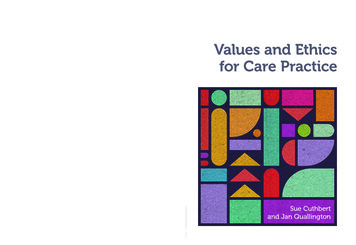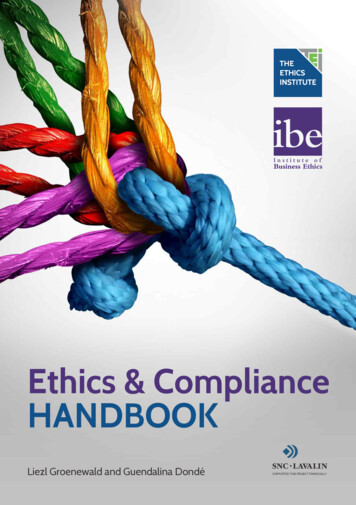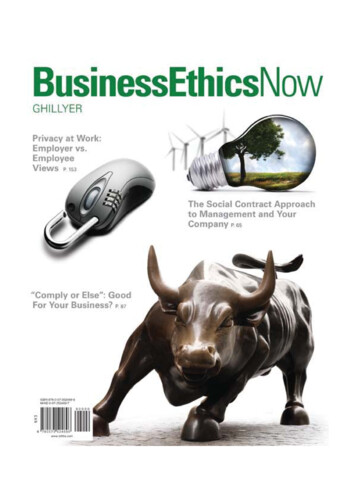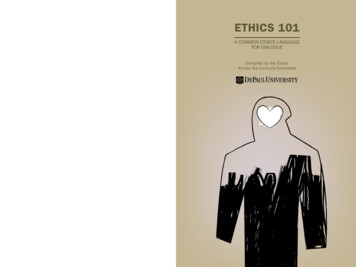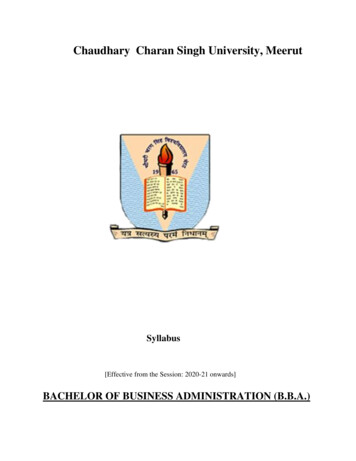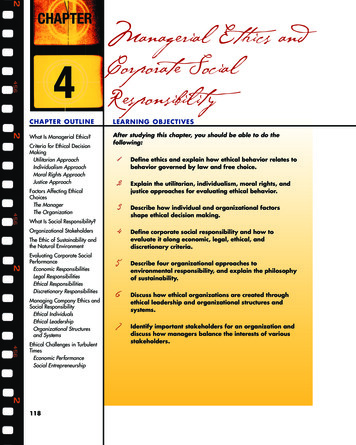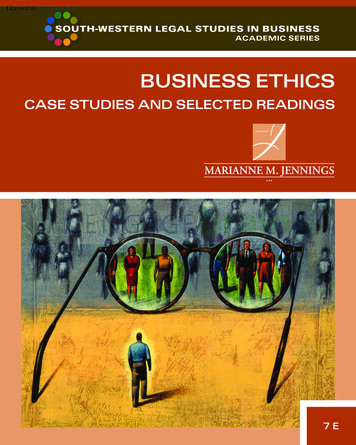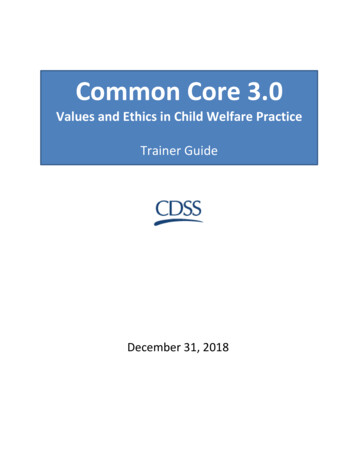
Transcription
Common Core 3.0Values and Ethics in Child Welfare PracticeTrainer GuideDecember 31, 2018
Table of ContentsAcknowledgements. 3Introduction . 4Tips for Training this Curriculum. 7Agenda . 9Learning Objectives. 10Lesson Plan. 11Segment 1: Welcome and Overview of the Day . 12Segment 2: The Building Blocks of Ethics in Child Welfare Practice. 15Segment 3: Ethical Codes, Standards, and Values . 18Segment 4: Identifying and Resolving Ethical Dilemmas . 24Segment 5: Closing. 35References/Bibliography. 36Materials Checklist . 37California Common Core Curriculum 3.0 Values and Ethics in Child Welfare Practice December 31, 2018 Trainer Guide2
AcknowledgementsCalifornia’s Common Core Curricula for Child Welfare Workers is the result of the invaluable work and guidance of agreat many people throughout the child welfare system in California and across the country. It would be impossible tolist all of the individuals who contributed, but some groups of people will be acknowledged here.The Content Development Oversight Group (CDOG) a subcommittee of the Statewide Training and EducationCommittee (STEC) provided overall guidance for the development of the curricula. Convened by the California SocialWork Education Center (CalSWEC) and the California Department of Social Services (CDSS), CDOG membership includesrepresentatives from the Regional Training Academies (RTAs), the University Consortium for Children and Families inLos Angeles (UCCF), and Los Angeles County Department of Children and Family Services.In addition to CDOG, a Common Core 3.0 subcommittee comprised of representatives from the RTAs, the ResourceCenter for Family Focused Practice, and counties provided oversight and approval for the curriculum developmentprocess.Along the way, many other people provided their insight and hard work, attending pilots of the trainings, reviewingsections of curricula, or providing other assistance.California’s child welfare system greatly benefits from this collaborative endeavor, which helps our workforce meet theneeds of the state’s children and families.The Children’s Research Center provided technical support as well as The Structured Decision Making System thatincludes the SDM 3.0 Policy and Procedure Manual and Decision Making Tools. These resources are used in compliancewith CRC copyright agreements with California. Additionally, content in this curriculum has been adapted from CRC’sSDM 3.0 classroom curriculum to meet the training needs in California. In compliance with the Indian Child Welfare Act(1978) and the California Practice Model, social workers must identify American Indian/Alaska Native children in thesystem. For an overview of implementing the Indian Child Welfare Act view:https://www.youtube.com/watch?v BIQG65KFKGsThe curriculum is developed with public funds and is intended for public use. For information on use and citation of thecurriculum, please refer s/citation guideline 6-2018.pdfFOR MORE INFORMATION on California’s Core Curricula, as well as the latest version of thiscurriculum, please visit the California Social Work Education Center (CalSWEC) website:http://calswec.berkeley.eduCalifornia Common Core Curriculum 3.0 Values and Ethics in Child Welfare Practice December 31, 2018 Trainer Guide3
IntroductionPlease read carefully as a first step in preparing to train this curriculum.IMPORTANT NOTE: Each curriculum within the Common Core series is mandated andstandardized for all new child welfare workers in the state of California. It is essential that alltrainers who teach any of the Common Core Curricula in California instruct trainees using thestandardized Training Content as provided. The training of standardized content also serves asthe foundation for conducting standardized testing to evaluate and improve the effectiveness ofnew worker training statewide.GENERAL INFORMATIONCommon Core curriculum and training for new child welfare workers in California is designed to be generalizable acrossthe state, cover basic child welfare knowledge and skills and is important for all CWS positions within an agency.The Common Core Curriculum model is designed to define clearly the content to be covered by the trainer. Eachcurriculum consists of a Trainee’s Guide and a Trainer’s Guide. Except where indicated, the curriculum componentsoutlined below are identical in both the Trainee’s and Trainer’s Guides. The Trainee’s Guide contains the standardizedinformation which is to be conveyed to trainees.For an overview of the training, it is recommended that trainers first review the Agenda and Lesson Plan. After thisoverview, trainers can proceed to review the activities for each training segment in the Trainer’s Guide and the TrainingContent in the Trainee’s Guide in order to become thoroughly familiar with each topic and the training activities. Thecomponents of the Trainer’s and Trainee’s Guides are described under the subheadings listed below.The curricula are developed with public funds and intended for public use. For information on use and citation of thecurricula, please refer to the Guidelines for /files/citation guideline 6-2018.pdfPlease note that each individual curriculum within the Common Core Curricula is subject to periodic revision. Thecurricula posted on the CalSWEC website are the most current versions available. For questions regarding the curricula,contact Calswec rta cc@berkeley.edu or call CalSWEC at 510-642-9272.COMPONENTS OF THE TRAINER’S AND TRAINEE’S GUIDESLearning ObjectivesThe Learning Objectives serve as the basis for the Training Content that is provided to both the trainer and trainees. Allthe Learning Objectives for the curriculum are listed in both the Trainer’s and Trainee’s Guides. The Learning Objectivesare subdivided into three categories: Knowledge, Skills, and Values. They are numbered in series beginning with K1 forknowledge, S1 for skills, and V1 for values. The Learning Objectives are also indicated in the Lesson Plan for eachsegment of the curriculum.Knowledge Learning Objectives entail the acquisition of new information and often require the ability to recognize orrecall that information. Skill Learning Objectives involve the application of knowledge and frequently require thedemonstration of such application. Values Learning Objectives describe attitudes, ethics, and desired goals andCalifornia Common Core Curriculum 3.0 Values and Ethics in Child Welfare Practice December 31, 2018 Trainer Guide4
outcomes for practice. Generally, Values Learning Objectives do not easily lend themselves to measurement, althoughvalues acquisition may sometimes be inferred through other responses elicited during the training process.AgendaThe Agenda is a simple, sequential outline indicating the order of events in the training day, including the coverage ofbroad topic areas, pre-tests and/or post-tests, training activities, lunch, and break times.Lesson Plan (Trainer’s Guide only)The Lesson Plan in the Trainer’s Guide is a mapping of the structure and flow of the training. It presents each topic andactivity and indicates the duration of training time for each topic.The Lesson Plan is divided into major sections by Day 1, Day 2, and Day 3 of the training, as applicable, and contains twocolumn headings: Segment and Methodology and Learning Objectives. The Segment column provides the topic andtraining time for each segment of the training. The Methodology and Learning Objectives column reflects the specificactivities and objectives that are covered in each segment. As applicable, each activity is numbered sequentially within asegment, with activities for Segment 1 beginning with Activity 1A, Segment 2 beginning with Activity 2A, etc.Evaluation ProtocolsIt is necessary to follow the step-by-step instructions detailed in this section concerning pre-tests, post-tests, and skillevaluation (as applicable to a particular curriculum) in order to preserve the integrity and consistency of the trainingevaluation process. Additionally, trainers should not allow trainees to take away or make copies of any test materials sothat test security can be maintained.Training Segments (Trainer’s Guide only)The Training Segments are the main component of the Trainer’s Guide. They contain guidance and tips for the trainer topresent the content and to conduct each Training Activity. Training Activities are labeled and numbered to match thetitles, numbering, and lettering in the Lesson Plan. Training Activities contain detailed descriptions of the activities aswell as step-by-step tips for preparing, presenting, and processing the activities. The description also specifies theTraining Content that accompanies the activity, and the time and materials required.Occasionally, a Trainer’s Supplement is provided that includes additional information or materials that the trainer needs.The Trainer’s Supplement follows the Training Activity to which it applies.Training Content (Trainee’s Guide only)The Training Content in the Trainee’s Guide contains the standardized text of the curriculum and provides the basis forknowledge testing of the trainees. Training activities are labeled and numbered to match the titles and numbering inthe Lesson Plan.Supplemental HandoutsSupplemental Handouts refer to additional handouts not included in the Trainee’s Guide. For example, SupplementalHandouts include PowerPoint printouts that accompany in-class presentations or worksheets for training activities.Some documents in the Supplemental Handouts are placed there because their size or format requires that they beprinted separately.California Common Core Curriculum 3.0 Values and Ethics in Child Welfare Practice December 31, 2018 Trainer Guide5
References and BibliographyThe Trainer’s Guide and Trainee’s Guide each contain the same References and Bibliography. The References andBibliography indicates the sources that were reviewed by the curriculum designer(s) to prepare and to write the main,supplemental and background content information, training tips, training activities and any other information conveyedin the training materials. It also includes additional resources that apply to a particular content area. The Referencesand Bibliography may include the following: All-County Letters (ACLs) and All-County Information Notices (ACINs) issued by the California Department ofSocial Services (CDSS); Legal References (as applicable); and General References and BibliographyIn certain curricula within the Common Core series, the References and Bibliography may be further divided by topicarea.Materials Checklist (Trainer’s Guide only)In order to facilitate the training preparation process, the Materials Checklist provides a complete listing of all thematerials needed for the entire training. Multi-media materials include such items as videos, audio recordings, posters,and other audiovisual aids. Materials specific to each individual training activity are also noted in the Training Segmentsin the Trainer’s Guide.Posters (Trainer’s Guide only)Some curricula feature materials in the Trainer’s Guide that can be used as posters or wall art.California Common Core Curriculum 3.0 Values and Ethics in Child Welfare Practice December 31, 2018 Trainer Guide6
Tips for Training this CurriculumPRE-READING AND PREPARATION SUGGESTIONThe Preamble and Statement of Purpose of the NASW Code of Ethics should be reviewed in preparation for teaching thisclass. They are very useful in talking about the complex role of the social worker and the social worker’s broad duties.Both also address the role of ethics in a profession and how codes of ethics are intended to anchor decision making,helping the professional wade through conflicting demands and expectations.FAMILY FRIENDLY LANGUAGETrainers are the example for modeling this for trainees. The hope is that the work is done with families, not on clients.Use words such as parents, young adults, youth, child, family rather than clients. We want to model that familiesinvolved in child welfare services are not separate from us as social workers, but part of our community. This is the goalof the CA Child Welfare Core Practice Model as well and reflects the behaviors we want to see demonstrated in socialworkers work with families. For more information on the Californian Child Welfare Core Practice Model visit theCalSWEC website at re-core-practice-model-0.SAFETY ORGANIZED PRACTICESome content in this curriculum was informed by the National Council on Crime and Delinquency (NCCD) and theNorthern California Training Academy as part of the Safety Organized Practice Curriculum. Please note, not all CaliforniaCounties are actively practicing Safety Organized Practice. However, the framework, principles and concepts areintegrated throughout the curriculum as tools and best practices. Safety Organized Practice (SOP) is a collaborativepractice approach that emphasizes the importance of teamwork in child welfare. SOP aims to build and strengthenpartnerships with the child welfare agency and within a family by involving their informal support networks of friendsand family members. A central belief in SOP is that all families have strengths. SOP uses strategies and techniques thatalign with the belief that a child and his or her family are the central focus, and that the partnership exists in an effort tofind solutions that ensure safety, permanency, and well-being for children. Safety Organized Practice is informed by anintegration of practices and approaches including: Solution-focused practice1Signs of Safety2Structured Decision Making3Child and family engagement4Risk and safety assessment researchGroup Supervision and Interactional Supervision51Berg, I.K. and De Jong, P. (1996). Solution-building conversations: co-constructing a sense of competence with clients. Families in Society, pp. 376391; de Shazer, S. (1985). Keys to solution in brief therapy. NY: Norton; Saleebey, D. (Ed.). (1992). The strengths perspective in social work practice.NY: Longman.2 Turnell, A. (2004). Relationship grounded, safety organized child protection practice: dreamtime or real time option for child welfare? ProtectingChildren, 19(2): 14-25; Turnell, A. & Edwards, S. (1999). Signs of Safety: A safety and solution oriented approach to child protection casework. NY:WW Norton; Parker, S. (2010). Family Safety Circles: Identifying people for their safety network. Perth, Australia: Aspirations Consultancy.3 Children’s Research Center. (2008). Structured Decision Making: An evidence-based practice approach to human services. Madison: Author.4 Weld, N. (2008). The three houses tool: building safety and positive change. In M. Calder (Ed.) Contemporary risk assessment in safeguardingchildren. Lyme Regis: Russell House Publishing.5 Lohrbach, S. (2008). Group supervision in child protection practice. Social Work Now, 40, pp. 19-24.California Common Core Curriculum 3.0 Values and Ethics in Child Welfare Practice December 31, 2018 Trainer Guide7
Appreciative Inquiry6Motivational Interviewing7Consultation and Information Sharing Framework8Cultural HumilityTrauma-informed practice6Cooperrider, D. L. (1990). Positive image, positive action: The affirmative basis of organizing. In S. Srivasta, D.L. Cooperrider and Associates (Eds.).Appreciative management and leadership: The power of positive thought and action in organization. San Francisco: Jossey-Bass.7 Miller, W.R., & Rollnick, S. (2012). Motivational Interviewing, (3rd Ed.). NY: Guilford Press.8 Lohrbach, S. (1999). Child Protection Practice Framework - Consultation and Information Sharing. Unpublished manuscript; Lohrbach, S. & Sawyer,R. (2003). Family Group Decision Making: a process reflecting partnership based practice. Protecting Children. 19(2):12-15.California Common Core Curriculum 3.0 Values and Ethics in Child Welfare Practice December 31, 2018 Trainer Guide8
Agenda Segment 1: Introduction to Course15 minutes Segment 2: The Building Blocks of Ethics in Child Welfare25 minutes Segment 3: Ethical Codes, Standards and Values65 minutes Break10 minutes Segment 4: Identifying and Resolving Ethical Dilemmas60 minutes Segment 5: Closing5 minutesCalifornia Common Core Curriculum 3.0 Values and Ethics in Child Welfare Practice December 31, 2018 Trainer Guide9
Learning ObjectivesKnowledgeK1. The trainee will recognize his or her role as an advocate and case manager in supporting the needs of children,youth, non-minor dependents, and families to achieve:a. Safetyb. Permanencyc. Well-beingK2. The trainee will recognize possible conflicts associated with efforts to engage with families (e.g., culturalexpectations, use of social media).K3. The trainee will be able to explain how professional values and ethics influence the decision-making process in childwelfare, including the convening of teams for decision-making and appropriate disclosure of information.K4. The trainee will recognize that the NASW Code of Ethics guides practice in CWS.SkillS1. Given a case scenario, the trainee will be able to identify strategies to avoid ethical conflict related to efforts toengage (e.g., cultural expectations, social media).ValuesV1. The trainee will value fair and equitable treatment of all people involved in child welfare including efforts to addressthe issue of disproportionality in child welfare.V2. The trainee will value continued awareness of how one’s own values may influence one’s decision-making process inpublic child welfare.V3. The trainee will value awareness of his/her own emotional responses to clients in areas where the trainee’s valuesare challenged.V4. The trainee will value conducting him or herself in accordance with the professional expectations set forth in theNASW Code of Ethics, the NASW Standards for Social Work Practice in Child Welfare, and the California Standardsand Values for Public Child Welfare Practice.California Common Core Curriculum 3.0 Values and Ethics in Child Welfare Practice December 31, 2018 Trainer Guide10
Lesson PlanSegmentMethodology and Learning ObjectivesSegment 115 minActivity 1A: Welcome and introductionsWelcome and IntroductionsActivity 1B: Overview of Agenda, Learning Objectives and GroupAgreementsPowerPoint slides: 1-2Learning Objectives: K2, K4, V2Segment 225 minActivity 2A: Brief Foundational Lecture on Values and Ethics In ChildWelfareThe Building Blocks of Ethics inChild WelfarePowerPoint slides: 5-10Learning Objectives: K1, V2Segment 365 minActivity 3A: NASW Code of Ethics Group ActivityEthical Codes, Standards, andValuesPowerPoint slides: 11-18Learning Objectives: K1,K3,K4,V2,V4Activity 3B: Overview of NASW Code of Ethics as It Applies toColleaguesPowerPoint slides: 19-22Learning Objectives: K1, K3, K4, V2, V410:45 – 10:55 am10 minBREAKSegment 460 minActivity 4A: Case Scenario Group ActivityActivity 4B: Case Scenario Large Group ActivityIdentifying and Resolving EthicalDilemmasPowerPoint slides: 23-28Learning Objectives: K1, K2, K3, S1, V1, V2, V3(optional) Activity 4C: VideoSegment 55 minActivity 5A: RTA-specific evaluation/satisfaction surveysRTA-specific participant surveyPowerPoint slide: 29California Common Core Curriculum 3.0 Values and Ethics in Child Welfare Practice December 31, 2018 Trainer Guide11
Segment 1: Welcome and Overview of the DaySegment Time:15 minutesActivity Time:Activity 1A: Welcome and Introductions (5 minutes)Activity 1B: Overview of Agenda, Learning Objectives and Group Agreements(10 minutes)Trainee Content:Trainee Guide, Learning ObjectivesMaterials:Laptop linked to large screen, chart pad, markersSlides:1-4Description of Activity:The trainer will introduce them self and facilitate a brief round of introductions. The trainer will introduce trainees to theTrainee’s Guide and review the course description, Agenda and Learning Objectives.Before the activity Have the PowerPoint displaying on the large screen starting on slide 1 before the class arrives. This training is intended to follow the morning training: Orientation to Child Welfare Practice and Common Core3.0 If following a morning training, Group Agreements have been established. Review and revisit them and see ifthere is anything that needs to be added. If you plan to develop Group Agreements, prepare your chart pad in advance with some initial agreements suchas starting and ending on time, sharing the floor, etc., as well as the established group agreements for CC3.0. Make sure all of the trainees have received their training materials.During the activity Welcome the trainees to the training and introduce yourself. Discuss logistics related to the training site (cell phones off, breaks, parking,bathroom).California Common Core Curriculum 3.0 Values and Ethics in Child Welfare Practice December 31, 2018 Trainer Guide12
Values and Ethics in Child Welfare Practice:The Foundation of Decision MakingCalifornia Common CoreDecember 31, 20182 Briefly introduce trainees to the Trainee Guide contents as a whole,placing special emphasis on this guide being utilized later on for activitiesrelated to the ethical codes, standards and values informing Californiachild welfare practice Review the Learning Objectives (included in the Trainee Guide). Make the connection between the agenda, Learning Objectives andsupporting materials, emphasizing the need for both an understanding ofthe NASW Code of Ethics, and the opportunity to apply the code to typical childwelfare case scenarios that raise ethical dilemmas. As you reach the Case scenarios bullet, try to point out that whenpresented with ethical dilemmas, it's always best practice and oftenmandated to consult your supervisor and follow her/his direction, andwhen in absence of that direction to follow strict policy. It is important tobuild a foundational understanding of ethics and practice the criticalthinking skills required to identify and help resolve ethical dilemmas asthey occur. Values and ethics ultimately inform the policies you arebound by, and those policies are adapted and improved over time as aresult of the important work you do and the important role you play inthe larger mission to improve the safety and well-being of the childrenand families you serve. Advance to the Group Agreements slide and review/remind trainees ofthe Group Agreements and add or modify as necessary based onparticipant input. Offer the following brief explanations of the Group Agreements asneeded (this will depend on whether or not this group has alreadyworked to establish Group Agreements). This activity provides a modelfor the group work social workers will do with child and family teams, soyou may wish to make that connection as well. Collaboration: We need engagement to have partnership and thatworks best in an atmosphere of empathy and acceptance. We arehere because we are professional social workers who share acommon concern for the safety and well-being of children. Remindthem how this casework skill will be needed when working withfamilies as they are the experts on their family. Social workers mustbe able to foster collaboration through empathy and acceptance inCalifornia Common Core Curriculum 3.0 Values and Ethics in Child Welfare Practice December 31, 2018 Trainer Guide13
order to complete a thorough assessment of the situation. Familiesneed to feel trust before they honestly examine themselves and lookat a problem and their part in it. Ask lots of questions: Point out that the trainer can’t make thetraining relevant for each person. There are many people in the roomwith different experiences and different needs. Trainees have tomake it relevant for themselves by asking lots of questions anddeciding how the experience might be helpful or not helpful to them. Be Open to Trying New Things: As professional we feel morecomfortable and competent sticking with what we know. We don’talways like it when new things come along. Sometimes it feelsuncomfortable to try new things, so we tend to back away tellingourselves things like “she doesn’t know what she’s talking about shehas never worked in our community with the people we work with ”But to learn something new we have to go through theuncomfortable stage to get to where it feels natural andcomfortable. With this Group Agreement, they are agreeing to trynew things even if they feel uncomfortable. Make Mistakes: As professionals, we don’t like to make mistakes.And when we make mistakes we feel discouraged and beat ourselvesup. But, if we are going to learn new things, we have to makemistakes. Even more important is the willingness to admit we arewrong even when we don’t want to be. Growth requires that we areopen to changing our minds based on new information received. Wemust be willing to put our own ideas aside to fully hear the views ofothers. Confidentiality: This is just a reminder that information aboutfamilies or other trainees shared in the training room should be keptconfidential. Be responsible for your own learning: As adult learners, we realizeyou come with knowledge, skills and experience. The intention ofthis curriculum is that you will have an opportunity to share this vialarge and small group discussions. Please come prepared to traininghaving taken any prerequisite eLearning or classroom trainings. Setaside this day for your learning, please do not bring work into theclassroom, this is distracting to other trainees as well as to thetrainer/facilitator. This includes being on time, sharing the floor, cellphones off, etc.Transition to the next segment: The Building Blocks of Ethics in Child Welfare PracticeCalifornia Common Core Curriculum 3.0 Values and Ethics in Child Welfare Practice December 31, 2018 Trainer Guide14
Segment 2: The Building Blocks of Ethics in Child Welfare PracticeSegment Time:25 minutesActivity Time:Activity 2A: Brief Foundational Lecture on Values and Ethics in Child Welfare (25minutes)Materials:Computer/laptop linked to large screen, chart paper, markersTrainee Content:N/ASlides:5-10Description of Activity:The trainer will provide an overview of the various strategies for thinking about ethics and introduce trainees to the keyareas of focus for ethical concerns in child welfare practice.Before the activity Write the values noted on the slide “Core Social Work Values” on individual flip chart pages and place the pageson the walls around the room.During the activity Ask trainees to write a brief, one sentence definition of ethics, and thenask several volunteers to share what they wrote. Ask volunteers to provide some educated guesses as to what previousexperiences might have informed the definitions provided. As the responses come in, make the connection between ethics andvalues, pointing out that our values inform our definition of ethics. Point out that conflict between and among values is common ineveryday life. When it comes to the professional environment, we relyon ethical codes/standards to guide our decision making. SW should seeethics as a way to guide right conduct that ensures consistency and adispassionate perspective. Review the historical ways of framing ethics: utilitarian, deontological,and virtue-based. Utilitarian Ethics: By thinking about the consequences of ourdecisions and actions, Utilitarian ethics—sometimes calledconsequentialist ethics—helps us make decisions that aim at "thegreatest good for the greatest number of people." Jeremy Benthamand John Stuart Mill developed utilitarianism as a way for membersCalifornia Common Core Curriculum 3.0 Values and Ethics in Child Welfare Practice December 31, 2018 Trainer Guide15
of British Parliament to make better laws. Today, utilitarianism is themost popular ethical theory for policy-making.Deontological Ethics: If you think about ethics as a matter offollowing the rules, then acting ethically depends on knowing whichrule to follow. For example, the rule “never lie” requires adherentsto tell the truth at all times.Virtue Ethics: Socrates (and his students Plato and Aristotle)thought that ethical decision making is something that comes fromknowledge and virtue, which ultimately lea
involved in child welfare services are not separate from us as social workers, but part of our community. This is the goal of the CA Child Welfare Core Practice Model as well and reflects the behaviors we want to see demonstrated in social workers work with families. For more information on the Californian Child Welfare Core Practice Model .

